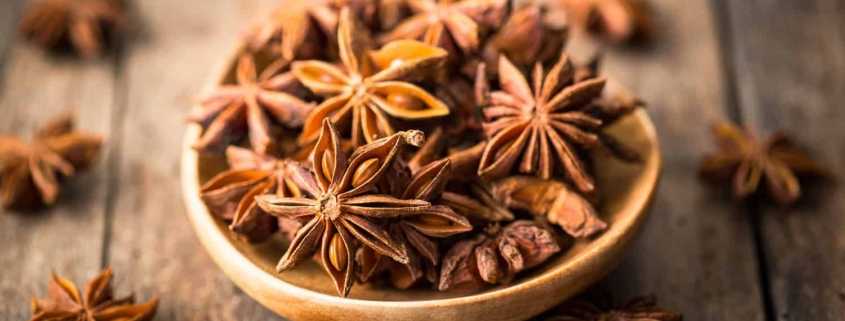Star Anise – Essential Oils benefits
Star Anise
Essential Oils benefits
Star anise is the seed pod from the fruit of the Illicium verum plant, an evergreen shrub grown in China, Indo-China, and Japan and sometimes referred to as Chinese star anise and has been used as a medicine and spice for more than 3,000 years. It is a native of Egypt, Greece, Crete, and Asia Minor and was cultivated by the ancient Egyptians. It was well known to the Greeks, being mentioned by Dioscorides and Pliny and was cultivated in Tuscany in Roman times. In the Middle Ages, its cultivation spread to Central Europe. During the late 1500s, star anise came to Europe via an English sailor and soon after was traded along the tea route from China through Russia. Because of its sweet flavor, star anise was mainly used in jams, syrups, and puddings and later substituted in commercial drinks for anise seed.
It is a pillar ingredient in Chinese cooking; it is one of the main flavors in Chinese five-spice powder and is also used to make tea and season roast duck and other meats. In Vietnamese cuisine, star anise is part of the well-known soup, pho. In Western cultures, it is more often used to flavor liqueurs, such as absinthe, sambuca, and pastis, as well as baked goods like cookies and cakes.
Star anise has a very strong, distinct flavor that is warm, sweet, and spicy, similar to licorice, fennel seed, clove, and anise seed of course. Although the flavor of star anise is generally thought of as sweet, it is commonly used in savory dishes; it pairs well with citrus, onions, poultry, beef, cinnamon, nutmeg, and ginger and should be used in small quantities.
Like just about every other scent, anise is one of those smells that you either love or desperately hate. If you’re not familiar with anise, think licorice; although the plant is not directly related to licorice, it has a very similar taste and smell
In Virgil’s time, Anise was used as a spice. Mustacae, a spiced cake of the Romans introduced at the end of a rich meal, to prevent indigestion, consisted of a meal with Anise, Cummin, and other aromatics. Such a cake was sometimes brought in at the end of a marriage feast, and is, perhaps, the origin of our spiced wedding cake.
On the Continent, especially in Germany, many cakes have an aniseed flavoring, and Anise is also used as a flavoring for soups.
Chinese medicine has used star anise for centuries, and Western medicine has recently begun to recognize this spice’s pharmacological and antimicrobial properties. Star anise contains shikimic acid, a compound that is found in Tamiflu, a treatment for influenza, and thus the spice has been used to treat coughs and flu-like symptoms.
Star anise is rich in antioxidants and vitamins A and C which help against diabetes and early signs of aging. It has also been shown to improve digestion, reducing bloating and gas, indigestion, and constipation.
For infantile catarrh, Aniseed tea is very helpful. It is made by pouring half a pint of boiling water on 2 teaspoonsful of bruised seed. This, sweetened, is given cold in doses of 1 to 3 teaspoonsful frequently.
The essential oil extracted from anise seed is known as anise oil and it offers several health benefits. Nevertheless, one should be cautious while using aniseed oil, which needs to be used in small quantities. Using anise oil in elevated concentrations or large amounts may cause more harm than benefits.
Its essential oil blends well with:
- cardamom
- caraway
- cedarwood
- coriander
- dill
- fennel
- mandarin
- petitgrain
- rosewood
For several centuries, people have been documenting the digestive attributes of anise oil, which facilitates digestion of heavy meals, particularly the digestion and absorption of sugary and oily foods. Provided you have had a heavy meal, add this oil to warm water and drink the solution after your meal – it will help to digest the ingested foods easily. Anise oil is also effective in reducing various gastric problems like flatulence. It also helps to alleviate constipation problems since it is an effective laxative. In addition, people enduring problems related to gas formation in the stomach and intestines will also find this oil beneficial. Since anise oil facilitates digestion, it prevents gas build-up in the digestive tract. It is also proven that this oil is effective for curing abdominal uneasiness like bloating, abdominal cramps and similar problems
Anise oil possesses detoxifying properties, the use of this oil helps to maintain the health of the hair as well as shining. This essential oil is excellent for head messages, as it helps to calm the scalp and, at the same time, works as a tonic for the hair, by encouraging hair growth. This oil also possesses antimicrobial and antiseptic attributes and this aids in getting rid of scalp infections. It can be blended with coconut oil and massaged on the scalp for treating problems related to the head. This oil is blended with shea butter and applied to the skin for treating skin complaints. It is also an excellent and effective remedy for treating acne.
The oil extracted from anise seed also works as a narcotic and does not give rise to any adverse side effects related to using synthetic narcotics. Anise seed oil inhibits circulation and also soothes hysteria attacks. It has been found that this oil is very beneficial for people who endure panic attacks and suffer from anxiety. This oil is effective for restoring mental tranquillity. Anise oil possesses sedative properties and can be used to treat sleep-related problems.
This oil is also a natural palliative. Anise oil aids in providing relief from symptoms of arthritis, rheumatism, and joint pains. Anise oil helps in alleviating the above mentioned problems as it aids in detoxifying the body and, henceforth, this oil works to promote blood circulation.
This oil also possesses anti-spasmodic attributes, which help in alleviating muscle pains and aches caused by spasms.
It also helps to open up blocked lungs, as it melts phlegm (mucus), thereby providing relief from various conditions associated with the respiratory tract. People enduring breathing problems like asthma and bronchitis will find this herb very beneficial, as drinking anise seeds added to hot water will provide relief from these disorders. Drinking anise seeds in hot water provides instant respite from the problems.
It possesses antiseptic attributes that are extremely useful in protecting the body from infections. This oil is often applied to wounds to prevent bacterial infections. Applying this oil to wounds accelerates healing, while the analgesic attribute of this oil reduces pain. Nevertheless, one should never apply this oil to puncture wounds and deep cuts. Anise oil is ideal for using on superficial cuts or abrasions.
In addition to the above-mentioned properties, this oil has a natural warming effect inside the body. Anise oil is useful for combating cold. Just a few drops of this oil to hot water and drink the solution to treat colds. As this oil possesses antiseptic and antimicrobial attributes, it aids in treating flu, which is attributed to microbes.
Anise oil is poisonous to smaller animals and insects. Hence, the smell of this oil keeps insects at bay. This is the main reason why anise oil is used as sprays, vaporizers and fumigants to keep insects away.
This oil possesses potent insecticidal attributes and is effective for eliminating worms from the intestines. This attribute of the oil is especially useful for children, as they are often affected by worms that afflict the intestines.
The oil extracted from anise seeds also invigorates the body by encouraging energy flow throughout the body. It is a potent insect repellent and is often employed for protection from insect bites. Anise oil eliminates germs inhabiting the stomach and intestines, thereby maintaining a healthy digestive system. In addition, anise oil is also considered to be excellent for healthy eyesight.
Anise oil is a good antiseptic and is used, mixed with oil of Peppermint or Gaultheria (Wintergreen) to flavor aromatic liquid dentifrices.
Oil of Anise is used also against insects especially when mixed with oil of Sassafras and Carbolic oil.
The fruit, or so-called seeds. When threshed out, the seeds may be easily dried in trays, in a current of air in half-shade, out-of-doors, or by moderate heat. When dry, they are greyish brown, ovate, hairy, about one-fifth of an inch long, with ten crenate ribs and often have the stalk attached. They should be free from earthy matter. The taste is sweet and spicy, and the odor aromatic and agreeable.
The commercial varieties differ considerably in size, but the larger varieties alone are official. The Spanish Anise, sold as Alicante Anise, is the largest and the best adapted for pharmaceutical use, yielding about 3 percent. of oil. Russian and German fruits are smaller and darker and are the variety generally used for distillation of the volatile oil. Italian Anise is frequently adulterated with Hemlock fruit.
Anise likes a sunny, sheltered site with well-drained, alkaline soil. It is suitable for all areas of North America, but the seeds won’t ripen without a good hot summer. Anise needs 120 days to produce fully ripened seed heads. It is annual and grows 1-2 feet high. It does not transplant well, though it will live happily in a pot indoors or on a patio. Sow in the late spring.
It is a good companion plant with coriander, but shouldn’t be grown with carrots.
Sow the seed in dry, light soil, on a warm, sunny border, early in April, where the plants are to remain. When they come up, thin them and keep them clean from weeds. Allow about a foot each way. The seeds may also be sown in pots in heat and removed to a warm site in May.
The seeds will ripen in England in good seasons if planted in a warm and favorable situation, though they are not successful everywhere, and can hardly be looked upon as a remunerative crop. The plant flowers in July, and if the season proves warm, will ripen in autumn when the plants are cut down and the seeds threshed out.
Pick the leaves as you need them and collect the flowers as they open. The fruits are ready for harvesting when they are gray-green at the tips. Cut the plant, retaining a good deal of stem and hang upside down in a paper bag to dry. The seeds will drop off and collect in the bottom. Store the seeds in a dark, dry place.
Gather the stems and dig up the roots in autumn.






















Leave a Reply
Want to join the discussion?Feel free to contribute!